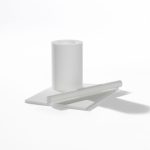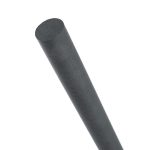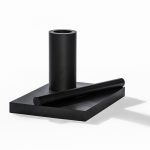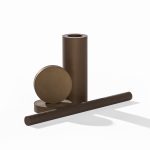PTFE
PTFE, otherwise known as polytetrafluoroethylene, is a synthetic, high-performance fluoropolymer of tetrafluoroethylene . The best know brand name of PTFE-based formulas is Teflon® (Chemours).
What is PTFE?
PTFE (polytetrafluoroethylene) is a thermoplastic polymer with a density of about 2.160 kg/m³. It gains its properties from the aggregate effect of carbon-fluorine bonds, as do all fluorocarbons. The fundamental difference is that this material is not melt-processable while all other fluoropolymers are. Standard PTFE is not suitable for injection moulding, blow moulding or vacuum forming.
What is PTFE used for?
This material has one of the lowest coefficient of friction of any known solid material. That makes it an excellent choice in applications that require anti-stick properties or that are sensitive to wear. But that is not the only trick up its sleeve. PTFE shows a high resistance to temperature, chemicals and even radiance. They also exhibit a high impact strength.
Pure PTFE has a wide range of applications. Typical applications include PTFE coatings for heat exchangers, electrical insulation, O-rings, seals and gaskets, seats and bearings, non-stick surfaces, linings for fuel hoses… Go to PTFE machined parts.
Which industries make use of PTFE?
Thanks to its excellent chemical and physical properties, PTFE is widely found in the semiconductor, pharmaceutical, automotive and chemical sector. For accurate dimensions, this material requires special attention during machining. For instance, special holding mechanisms are necessary to account for the softness of the material. Especially where no high mechanical strength is required and where the use of compounds is not allowed. A vast variety of compounds is available on the market: filters such as glass fibre, carbon, graphite, bronze, stainless steel, mica are being used to improve the original properties.
The advantages of using PTFE
The advantages of PTFE are a direct cause of their properties. Since PTFE is extremely durable. Thanks to it chemical resistance to corrossive materials and non-flammability, PTFE is used in a wide variety of cases. Thanks to it low friction, it can be used as coating for moving parts. Causing less heat, friction and strain on the machine.
Stock shapes
Relevant links
PTFE key properties
- Chemical inertness
- High temperature resistance
- Super high melt viscosity
- Hydrophobic
- Excellent dielectric properties
- Electrical isolating properties
- Fire resistant
- Chemical/thermal resistant
- FDA approved
PTFE uses
- Wiring in aerospace and computer applications
- Petrochemical and chemical processing
- Electrical applications: best insulators known
- Semi-conductor industry
- Food, beverage and pharmaceutical industries
- Laboratory applications: piping, tubing and vessels
- Custom moulded and machined parts
PTFE compounds
+15% OR 25% GLASS

Glassfilling slightly increases PTFE’s very low coefficient of friction, but considerably increases wear and pressure resistance.
+15/5% GLASS/MOS2

Shows the same pressure resistance as glassfilled PTFE, but uses MoS2 as a lubricant. Molybdenum also increases hardness and decreases wear.
+25% CARBON/GRAPHITE

Carbon is one of the best fillers for chemical use. It features high heat conductibility and high wear and pressure resistance.
+25% CARBON

Same as carbon/graphite, but with improved stiffness, reduced creep and reduced thermal expansion. Allowed for steam applications.
+10% SUMICASUPER

Exceptional filler component to improve the mechanical properties without increasing the porosity.
+60% BRONZE
 This connection combines a low coefficient of friction with a high pressure resistance. Both properties make it an excellent material choice for bearings.
This connection combines a low coefficient of friction with a high pressure resistance. Both properties make it an excellent material choice for bearings.

